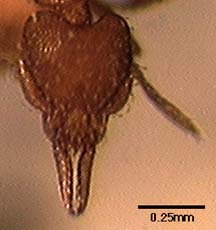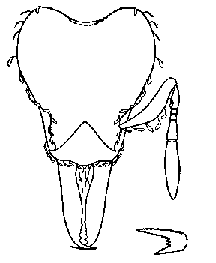Strumigenys subedentata Mayr 1887
Dacetonini, Formicidae, Hymenoptera, Insecta, Arthropoda, Animalia
John T. Longino, The Evergreen State College, Olympia WA 98505
USA.
longinoj@evergreen.edu
16 April 1997
|

Specimen: Costa Rica, Prov. Heredia: La Selva (Longino #3152). INBIOCRI001224829. Image by J. Longino.
Identification
Apical fork of mandible small, with two tiny intercalary denticles; mandibles thick with distinctly convex inner margins; close to the apical fork is a small preapical tooth, followed closely by 3-5 smaller denticles; ground pilosity conspicuous and abundant, particularly on head; hairs on head spoon-shaped and reclining.
Head length 0.48-0.56mm, mandible length 0.26-0.30, CI 82-86, MI 53-54 (n=36 workers from 15 localities; Brown 1962).
Similar species: gundlachi, eggersi, trieces.
Range
Throughout mainland tropical America, from southern Brazil to southern Mexico. Costa Rica: Atlantic and southern Pacific lowlands, upper Pacific slope of Cordillera de Tilaran.
Natural History
Brown and Wilson (1959) summarize the genus as follows:
"Widespread in tropics and warm temperate areas. Primarily forest-dwelling; some species occur in grassland and arid scrub. ... Nests mostly in soil and rotting wood; a few species live in arboreal plant cavities in tropical rain forest. Foraging hypogaeic to epigaeic-arboreal. Food: most species are collembolan feeders; a few are polyphagous predators or occasionally feed on sugary substances..."
|

Specimen: Costa Rica, Prov. Heredia: La Selva (Longino #3152). INBIOCRI001224829. Image by J. Longino.

Face view of worker and, magnified at lower right, anterior view of apical fork of mandible. Drawing based on Brown (1960, 1962).
|
Brown (1960) characterizes the species as follows:
"...primarily a species of the leaf litter and upper soil layers in mesic tropical forest. Nests have been found on the underside of a small log buried in leaf litter, in a small pocket in the soil, and among rotting leaves and twigs. In life, the workers are active huntresses ... E. O. Wilson (unpubl. notes) kept a colony from Veracruz alive and gave them a variety of small arthropods, among which they accepted as prey entomobryoid Collembola, while ignoring over two days small millipeds, Reticulitermes nymphs, a small isopod, and an undetermined soft-bodied mite. The colonies so far found have contained from about 20 to 90 workers and one or more queens."
In Costa Rica this species appears relatively common in lowland moist to wet forest on the Pacific slope, but rare in the Atlantic lowlands. I observed one colony under a bark flap, low on a tree trunk, and a worker was carrying a collembolan prey item.
Selected Records
Winkler samples from La Selva, road to Monteverde at 900m (islolated patch of evergreen forest in ravine), Carara, Manuel Antonio National Park, Osa Peninsula (Rancho Quemado), Corcovado National Park (Sirena), 19km S Ciudad Neily.
La Selva: night collecting in arboretum; nest under barkflap at base of big Pithecellobium tree; Collembola (prey?) also in collection; a worker seen carrying one at time of collection.
Literature Cited
Brown, W. L., Jr. 1960 (1959). The neotropical species of the ant genus Strumigenys Fr. Smith: Group of gundlachi (Roger). Psyche 66:37-52.
Brown, W. L., Jr. 1962. The neotropical species of the ant genus Strumigenys Fr. Smith: Synopsis and keys to the species. Psyche 69:238-267.
Brown, W. L., Jr., Wilson, E. O. 1959. The evolution of the dacetine ants. Quarterly Review of Biology 34:278-294.
 Go back to top
Go back to top


